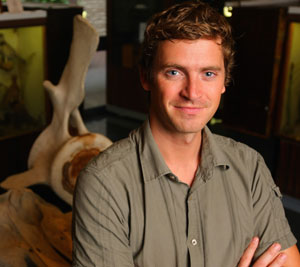 |
| Dal's Derek Tittensor is the lead author of the Canada-U.S. study. (Nick Pearce Photo.) |
The international project also includes Dal professors Camilo Mora, Heike Lotze, Daniel Ricard and Boris Worm, Edward Vanden Berghe from Rutgers University, and Walter Jetz from Yale University.
By studying a broad range of species, both big and small, researchers were able to draw conclusions and map certain āhot spotsā of diversity.
āAreas that we identified as hot spots had higher numbers of multiple species,ā says Dr. Tittensor, postdoctoral fellow with Dalhousieās Department of Biology. āUnfortunately, these areas also tend to be more vulnerable to outside influences such as commercial fishing, pollution and other types of habitat interference.ā
The one thing that areas of marine biodiversity appear to have in common is temperature. Typically, areas that are hot spots of diversity have higher temperatures, but this is not always the case. The areas around the North and South Poles are home to many species of marine life such as seals, whales and multiple species of fish. Even so, Dr. Tittensor warns we should still be very concerned about the rising temperature of our worldās oceans.
āThe main goal of this research was to be able to better inform conservation and management of the environment in regards to the ocean and marine life. By highlighting areas of marine biodiversity we can hopefully better manage them,ā he notes. āThis study will also be able to provide a baseline for future research. Forty or 50 years from now, researchers will be able to use this study as a baseline measurement and track changes in the marine environment.ā
The study authors point out the diversity of life in the global ocean is severely threatened. A steady onslaught of exploitation, habitat alteration, pollution and climate change auger a menace to the very makeup of the oceans. The authors suggest that limiting ocean warming and other human impacts is key to secure these hotspots of marine biodiversity in future.
The research findings are published in the July 28, 2010 edition of the scientific journal Nature.
SEE THE ARTICLE: in Nature
